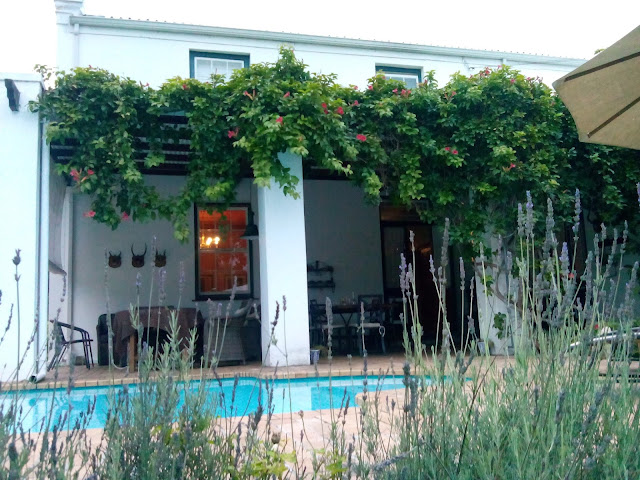Both Desmond and I grew up with mothers who made Ginger beer and Grenadila (Also known as Passion Fruit) cordial as a summer cool drink.The Ginger beer was only allowed to brew to make it fizzy and non alcoholic (although I do remember becoming quite tipsy once because I scoffed down the delicious swollen raisins that I was supposed to discard!)
Desmond's mother often made Grenadilla Cordial and looking at our harvest this year the guests will be treated to Grenadilla cordial in a big way:
For every 2 cups of Grenadilla pulp, you add the juice of 3 oranges and 1 lemon. Heat 3 cups of water and dissolve 2 cups of sugar to make a thin syrup. You then add the fruit to the syrup and bottle it. It is very good diluted with soda water and ice. And a shot of Vodka and a mint leave will turn it into a summer Cocktail!
My mother made delicious Pineapple beer. She only used the rind and core, but you can use one whole small pineapple :
You will need 1 small pineapple, 2 liter water and sugar to taste.
Wash the pineapple and cut it chunks before you crush the whole lot , skin and all, in a blender or food processor (my mother used an old fashioned hand operated meat grinder) Pour the water over it and allow to stand for 12 to 16 hours at room temperature. At this stage it will smell like Pineapple beer and small bubbles will form. Add the sugar and stir to dissolve. Pour it through a very fine sieve (I still use 'cheese-cloth') and pour it in bottles, being careful not to fill the bottle to the top - leave about 5 cm gap to allow for the natural fermentation that will take place. Seal the bottles and leave in a cool pantry or similar spot for about 24 hours before you put it in the fridge to cool for the most refreshing summer drink you can imagine.
Ginger Beer:
You will need 250 gram raisins (with pips), 750 ml water, 1 kg sugar, 40 gram crushed ginger, 7 liter cold water and 12,5 ml tartaric acid (wynsteensuur in Afrikaans).
Keep a handful of raisins aside, then boil the rest of raisins in 750 ml water for about 10 minutes. Remove from the heat and squash the raisins. Pour into a glass jug, cover with a clean cloth and leave in a warm place until the raisins move to the top. Remove the raisins, set the starter fluid (called 'mos') aside and start the next phase:
Heat 1 kg sugar, the ginger and 7 liter of water to boiling point and stir until the sugar is dissolved. Allow it to cool down (it must still be warm though) Add the handful of raisins that you initially kept aside, add the 12,5 ml wine acid and the starter fluid/'mos' to the sugar water. Leave it overnight.
When it starts to form bubbles you pour it through a fine sieve or 'cheesecloth' to remove the grapes and ginger. Pour into bottles (allowing about 3 cm below the cork or bottle cap) It will keep for a few days in the fridge.
Iced Tea:
One year Desmond and I traveled to the west coast to look at veld flowers and we bought the most delicious iced tea from the local VLV ladies. To our surprise we found the "recipe" to be quite simple: they merely cooled off strong Rooibos tea which they mixed to taste with apple juice! Add a few slices of lemon juice and you'll be drinking summer!
Guests at Fairview are treated to my homemade grape juice in summer. I harvest the Catawba grapes from the vine above our front stoep, simply putting it in my blender with some Rooibos tea added after I've given it a good wash (Desmond doesn't spray the grapes, we therefore have little spiders and other goggos on it) This is then poured onto a muslin lined strainer and left to run through (helped along by pressing down with the back of a wooden spoon every now and then) At the beginning of the season the grapes are not all that sweet yet and I have to add sugar to taste. I also add about 5 ml of grenadine to enhance the colour. Two years ago Desmond tried his hand at making home-made wine from the grapes. Unfortunately that ended as a good vinegar, but as Desmond philosophically commented: rather a good vinegar than a bad wine!


